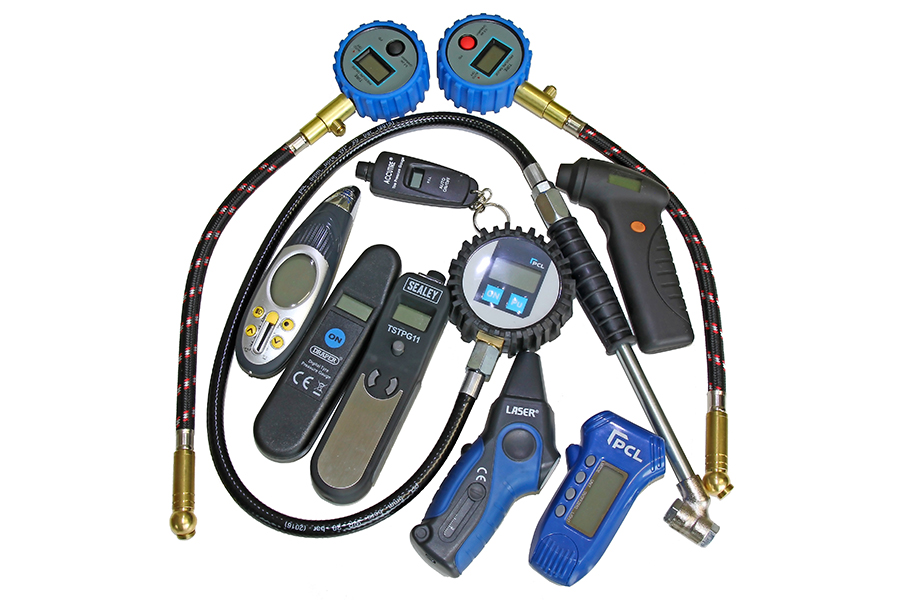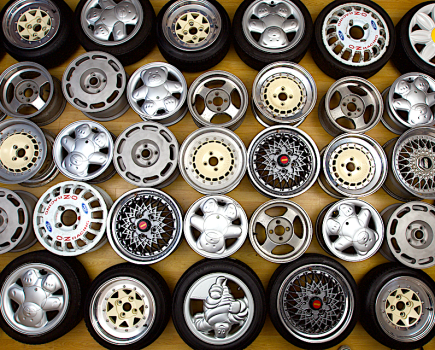A digital tire pressure gauge is a great tool for keeping on top of your car maintenance. We pitched 10 against each other to assess their accuracy, ease-of-use and cost effectiveness.
Ensuring your tire pressures are correct is not a major concern for most motorists, until you realize the consequences of an over- or under-inflated tire. Excessive wear, increased fuel consumption and poor handling are some of the problems that can arise, not to mention the safety concerns. So, if you’re keen to maintain your tire pressures, a pressure gauge is a worthwhile investment.
There are hundreds of different types of tire pressure gauge, including units with analogue or digital readouts, gauges on foot pumps and combined electric inflators/gauges. We decided to narrow down the choice and test 10 digital types. These promise to be accurate and easy to use, while many have useful built-in features such as a backlight to help see the readout in the dark and a torch to help locate the tire valve. Some can also measure tread depth and most of them can provide tire pressure measurements in Psi (pounds per square inch), Bar, Kg/cm2 and kPa (kilopascal).
Rob Hawkins spent several months testing all of the gauges and discovered some interesting differences to help us pinpoint the best and worst. The prices quoted are the recommended retail prices and you can often find cheaper prices by shopping around. Rob is a regular contributor to the popular Car Mechanics magazine. He’s an experienced writer and product tester who has been working on cars for decades. This involves restoring vehicles as magazine projects as well as testing the latest products.
At a glance:
- Best Buy: PCL DTPG7, RRP: £31.87. Buy now.
- Best Budget Buy: Blackline SWE310, RRP: £4.56. Buy now.
- Recommended: Ring Automotive RTG7, RRP: £24.99. Buy now.
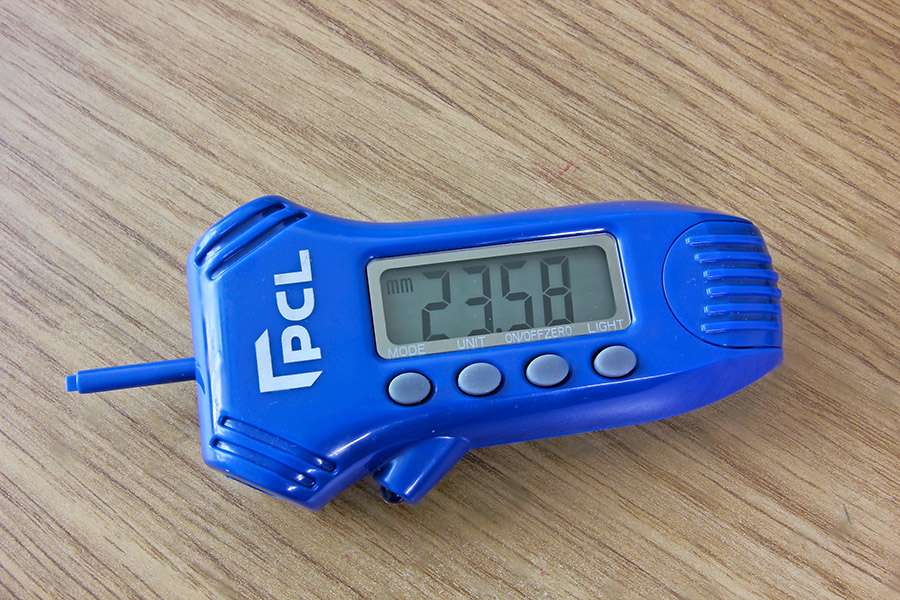
PCL DTPG7 Digital Tire Pressure Gauge – Best Buy!
Score: 9/10 – Best Buy!
Measurements: Psi, Bar, Kg/cm2
Decimal places: 1-2
Accuracy: +3%
Batteries: CR2032
Backlight: Yes
Torch: Yes
Price: £31.87. Buy now.
Of all the compact handheld tire pressure gauges on test, this one is easiest to understand. Four labelled buttons clearly explain each function, so you can see how to switch on the gauge, choose the correct unit of measurement and take a reading. A button labelled ‘LIGHT’ switches on the backlight upon the first press. Then a blue torch (keeping the backlight on as well). It then switches both of them off with a third press.
A ‘MODE’ button switches between pressure readings and a millimeter scale for a digital tread depth function. At first, this had us puzzled. That was until we spotted a plastic tag on the back of the gauge, which is the slider for the tread depth gauge that protrudes out of the top of the device. As all the rest of our gauges on test produce analogue readings for tread depth. This is seemingly the most accurate and easiest to read. Overall, this gauge is straightforward to use and its single CR2032 battery is simple to access and change. At times, it was difficult to locate the gauge onto the tire valve and see the readout. However, upon releasing it, the pressure reading remained displayed. Its recommended price is high compared with many of the other gauges on test, although we found one for half this cost on Amazon.
We check 1,000s of prices on 1,000s of retailers to get you the lowest new price we can find. Fastcar may get a commission from these offers. Read more here.
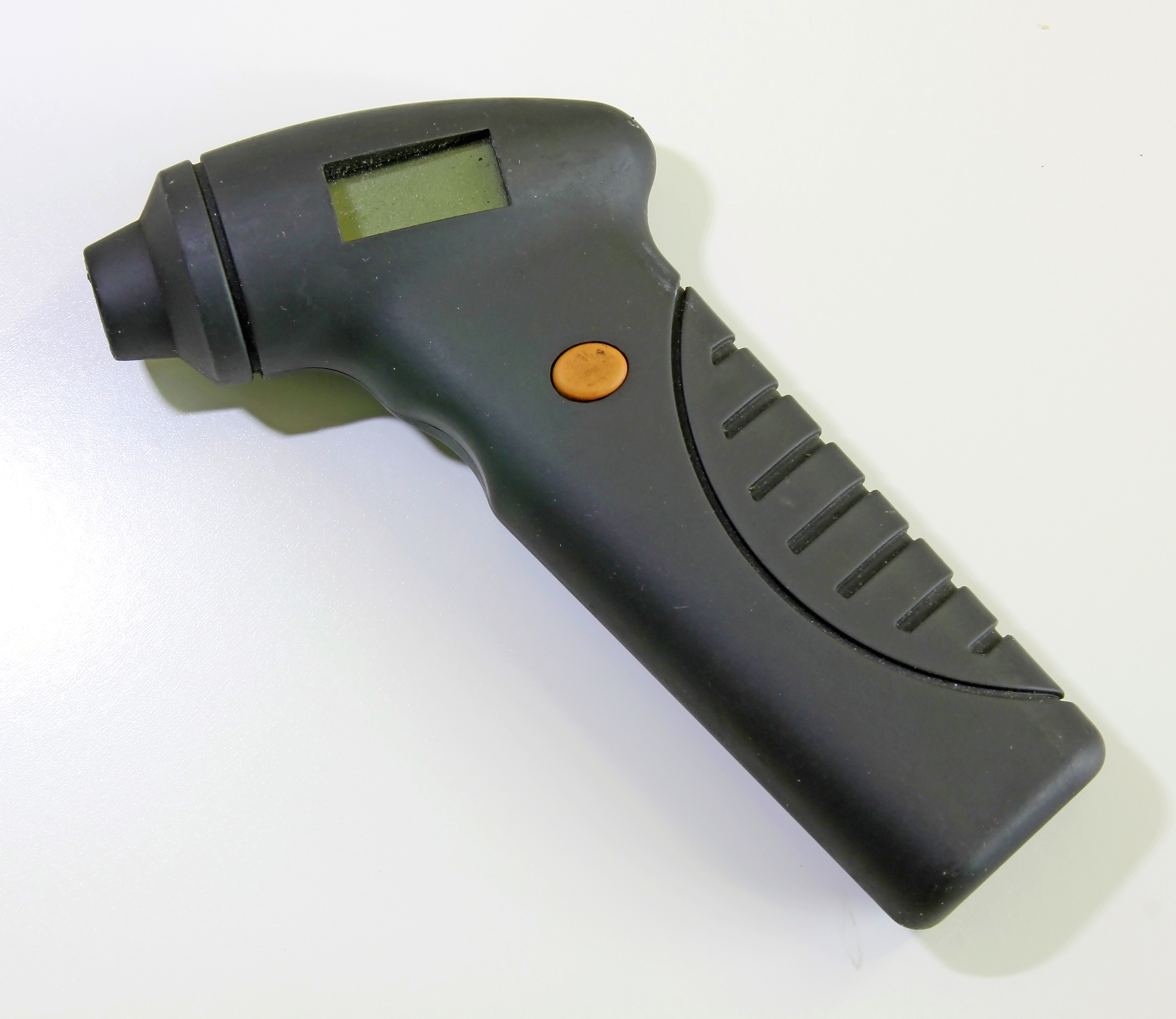
Blackline SWE310 – Best Budget Buy!
Score: 8/10 – Best Budget Buy!
Measurements: Psi, Bar, kPa, Kg/cm2
Decimal places: 1-2
Accuracy: +3.5%
Batteries: Cannot be replaced
Backlight: No
Torch: No
Price: £4.56. Buy now.
The cheapest of our digital tire pressure gauges on test, so if all you need is a no frills device, this may be the answer. There are no extras, such as a backlight, torch or tire tread depth gauge. However, the gauge does provide the full range of tire pressure measurements. On the downside, there’s no means of replacing the battery or batteries because it’s a sealed unit. That being said, we’ve been using the gauge shown here for three years and it has yet to fail.
The plastic construction of the gauge, particularly the part that fits over the Schrader valve, appears to be more reliable at providing a reading than many of the more expensive gauges we tested. Our lab tests showed this gauge to be one of the least accurate. However, we’re talking 0.9% less accurate than the best gauge on test. If you have a number of cars and want to carry a tire pressure gauge in each, this may be the most cost-effective solution.
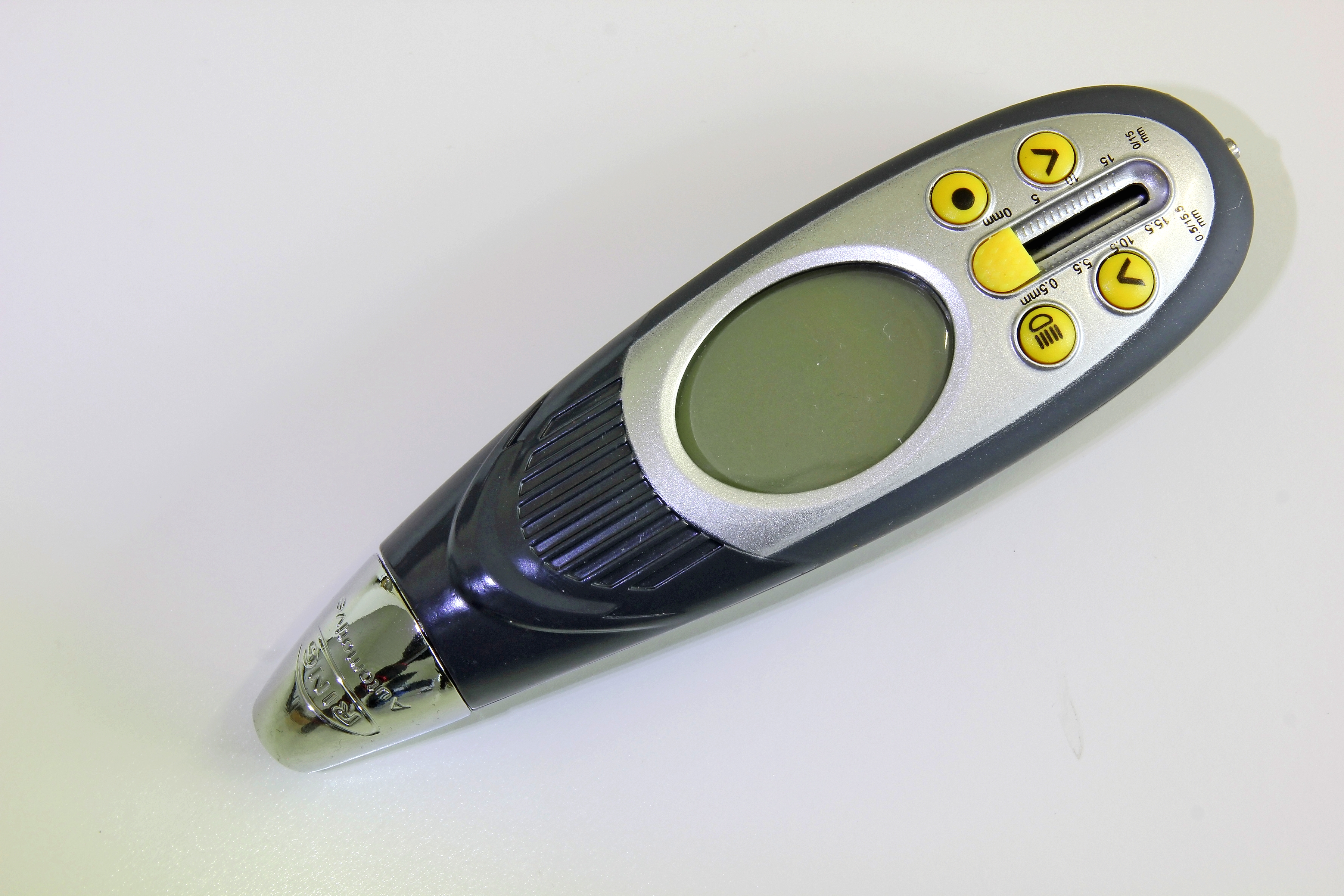
Ring Automotive RTG7 – Recommended!
Score: 8/10 – Recommended!
Measurements: Psi, Bar, kPa, Kg/cm2
Decimal places: 1-2
Accuracy: +2.7%
Batteries: CR2032 x 2
Backlight: Yes
Torch: Yes
Price: £24.99. Buy now.
This is the only unit with an adjustable, 360° swivel-head. As a result, the angle that the gauge is fitted onto a valve can be altered, although we sometimes struggled to fit it without allowing air to escape. It’s the heaviest unit on test, weighing 168g (the lightest is the Accutire at 21g and the next heaviest is Sealey’s TSTPG11 at 73g), and the only one supplied in a small fabric carry case.
Ring’s gauge includes a useful memory function. This displays values for the front and rear tire pressures. The values are straightforward to set and the readout not only displays the tire pressure, but also whether the reading is low, high or OK. The tire pressure doesn’t need to be spot-on to get an OK. We tested a tire that was a mere 0.1psi lower than the value stored in the memory and the readout said it was OK.
Other features include a torch and a tread depth indicator. The readout is permanently backlit and the gauge is powered by two CR2032 batteries. These are accessed via a panel on the back and a single crosshead screw. The memory function was retained when we removed the batteries for a few seconds and refitted them. The tread depth indicator provides a range from 0.5-15.5mm. For tires that are close to the UK’s 1.6mm limit, the scale can be difficult to read, even if you’re being a little cautious at 2-3mm.
We check 1,000s of prices on 1,000s of retailers to get you the lowest new price we can find. Fastcar may get a commission from these offers. Read more here.
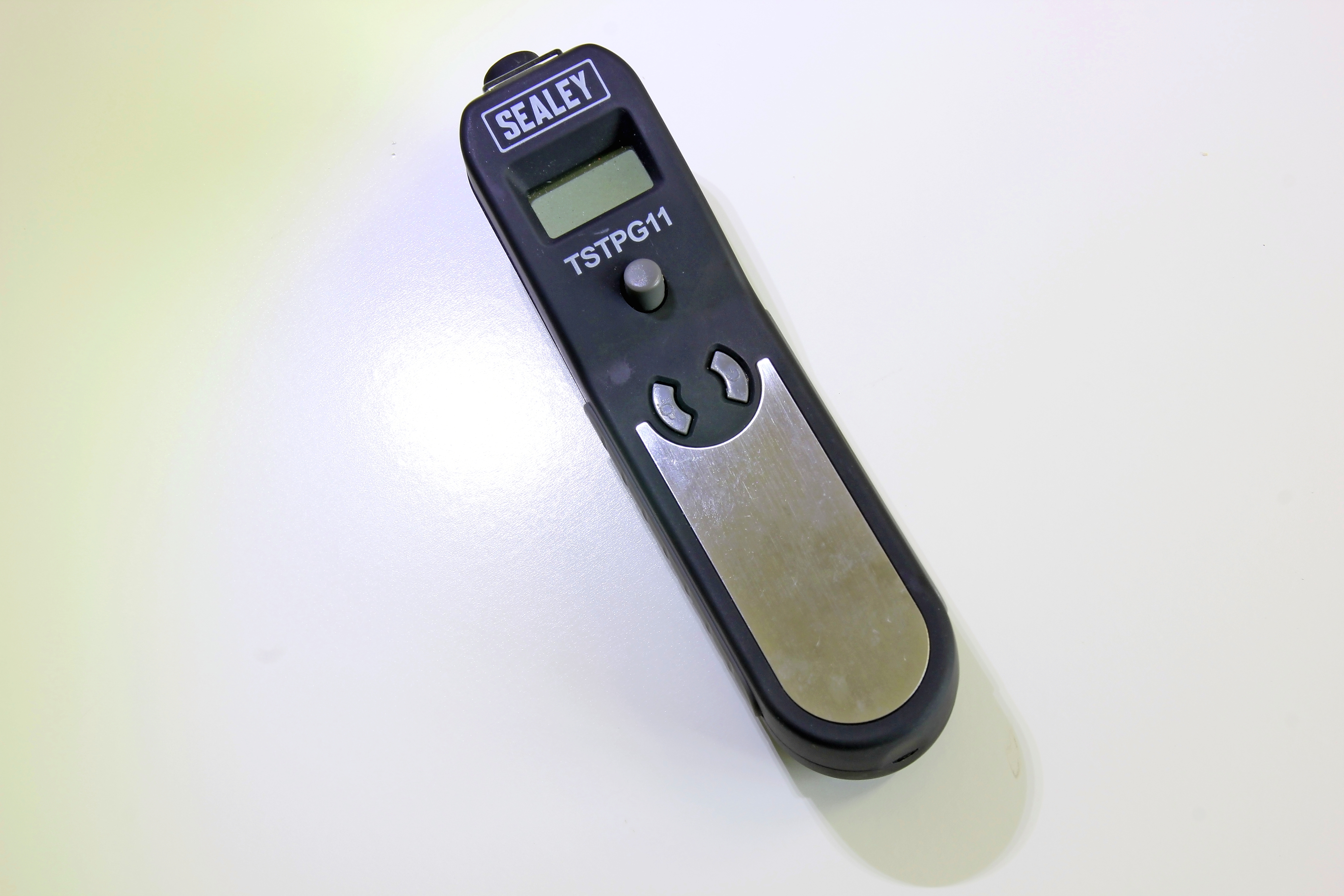
Sealey TSTPG11
Score: 7/10
Measurements: Psi, Bar, kPa, Kg/cm2
Decimal places: 1-2
Accuracy: +3%
Batteries: CR2032 x 2
Backlight: Yes
Torch: Yes
Price: £13.00. Buy now.
Similar in design to Draper’s gauge, but with the added bonus of a torch, backlight and a tire tread depth gauge, although the latter was quite stiff and awkward to operate, making it difficult to obtain an accurate reading if a tire was close to the UK legal limit of 1.6mm. The attachment that fits over the Schrader valve is manufactured from plastic or a similar composite. It was occasionally awkward to correctly locate, especially if a tire valve was damaged.
With a couple of small buttons to operate the light, switch the gauge on and off, and toggle between the different measurement scales, we needed our reading glasses to identify the symbols on them, but could guess by simply pressing them. A larger button in the center of the gauge is a useful bleed valve. It allows air to be let out of a tire if it has been over-inflated, while still monitoring its pressure on the readout (not explained in the instructions).
The two CR2032 batteries that power this gauge are quite fiddly to extract by hand, but easier with a small screwdriver. However, we did discover they should spring out when the cover is off and they were indeed launched into the air!
We check 1,000s of prices on 1,000s of retailers to get you the lowest new price we can find. Fastcar may get a commission from these offers. Read more here.
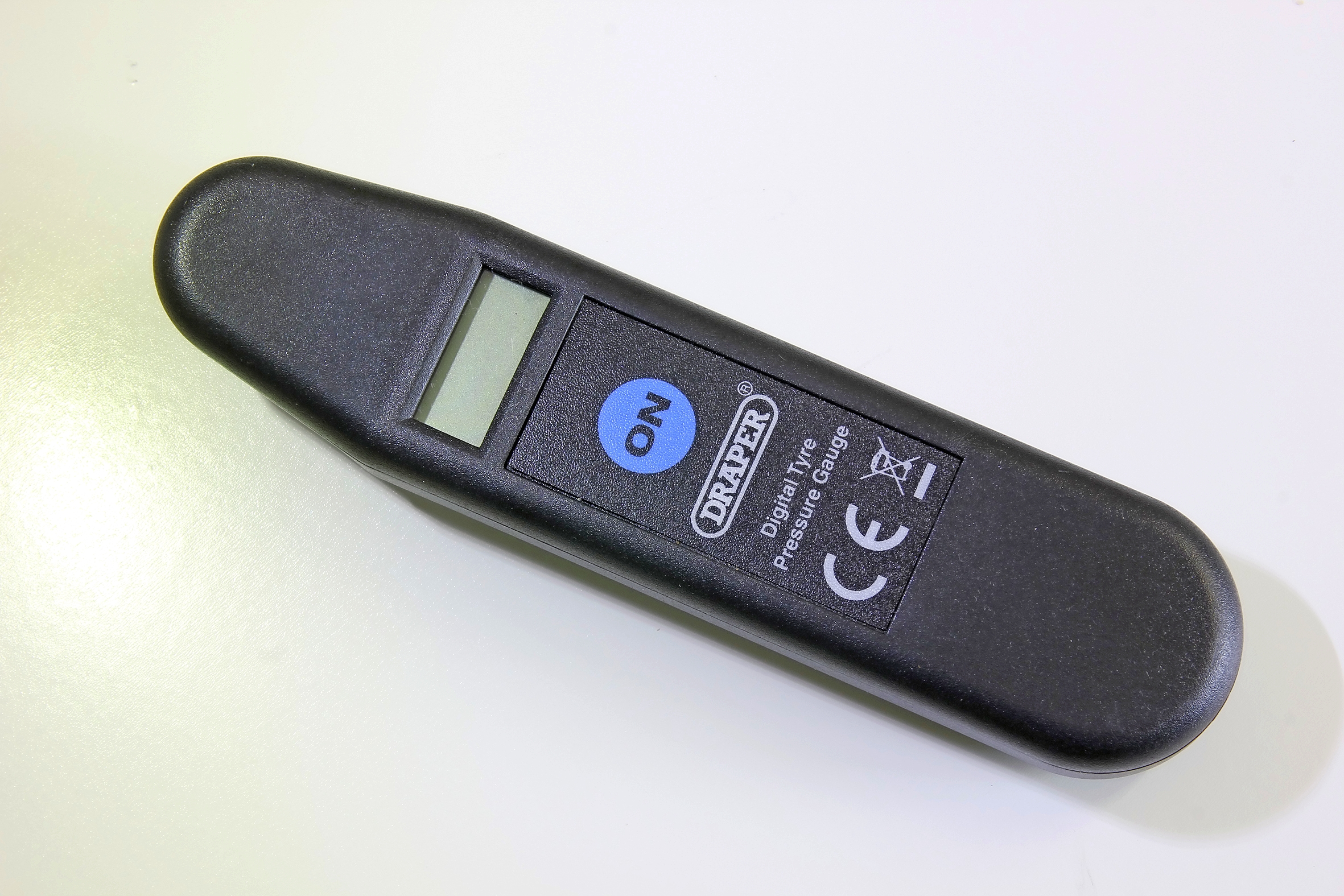
Draper 68474
Score: 7/10
Measurements: Psi, Bar, kPa, Kg/cm2
Decimal places: 1-2
Accuracy: +2.6%
Batteries: AG13 x 2 (3v)
Backlight: No
Torch: No
Price: £10.80. Buy now.
This is the only digital gauge on test that beeps when switched on and again when a reading has been taken. Draper’s gauge offers a wide range of readings, including the more modern kPa, which is used on a number of European vehicles including our Vauxhall Insignia and the latest Mercedes-Benzes. The chunky traditional watch-style batteries that power it are quite fiddly to extract with your finger, but straightforward to fit.
The attachment that fits over the Shrader valve appears to be made from plastic and was quite awkward at times to correctly locate and obtain a reading. Plus, the angle at which the gauge needs to be positioned was sometimes difficult to apply. However, the resounding beep at least indicated that a reading had been taken and could then be read by removing the gauge from the valve.
The gauge switches off automatically, but can also be switched off by holding down the ‘ON’ button. With no backlight or torch, it’s not particularly useful in low light, unless you have another source of illumination.
We check 1,000s of prices on 1,000s of retailers to get you the lowest new price we can find. Fastcar may get a commission from these offers. Read more here.
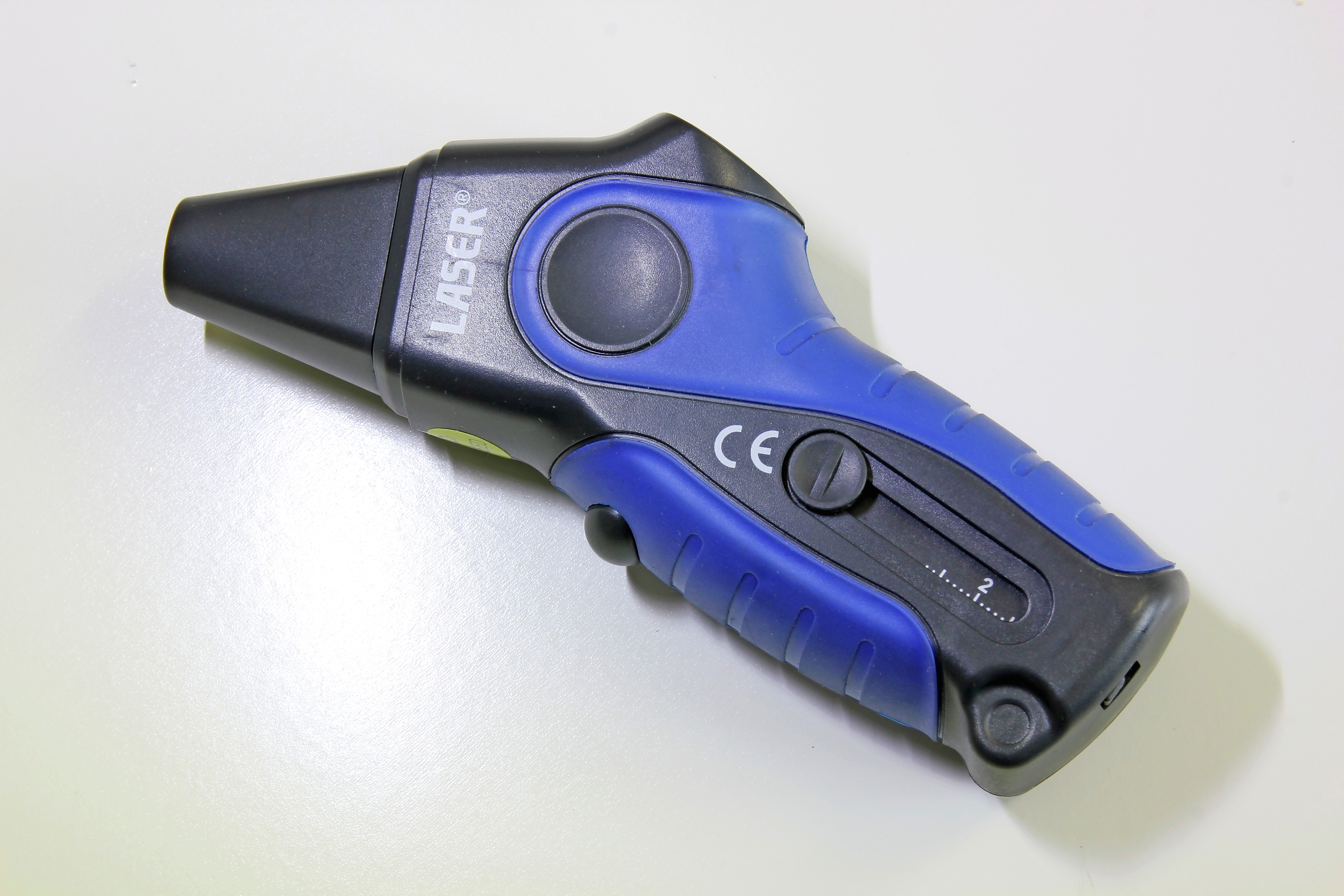
Laser 4886 Digital Tire Pressure Gauge
Measurements: Psi, Bar, Kg/cm2
Decimal places: 1-2
Accuracy: +3.4%
Batteries: LH44 x 2
Backlight: Yes
Torch: No
Price: £16.30. Buy now.
At first sight, this appears to be one of the better designs of handheld gauges, with a conical end to help locate it onto a tire valve. Some of our testers appreciated this. However, others found it awkward to position and see the readout. In addition, we all struggled to take a reading if a tire valve was damaged.
There’s one button on this gauge, which turns on the readout, changes the units of measurement and allows the gauge to be switched off (or it switches off automatically after 85 seconds), so it’s very straightforward to use and understand. The battery compartment is easy to access via a small cover and, once removed, a firm tap against the palm of your hand releases the two chunky LH44 watch batteries (which is better than them being loose).
The mechanical slider for measuring tire tread depths can be locked in the closed position to avoid the risk of it protruding and getting broken. The depth is a little awkward to read because the measurements are on the part that protrudes; for anything below 5mm, the slider fully retracts and becomes locked inside the body of the gauge.
We check 1,000s of prices on 1,000s of retailers to get you the lowest new price we can find. Fastcar may get a commission from these offers. Read more here.
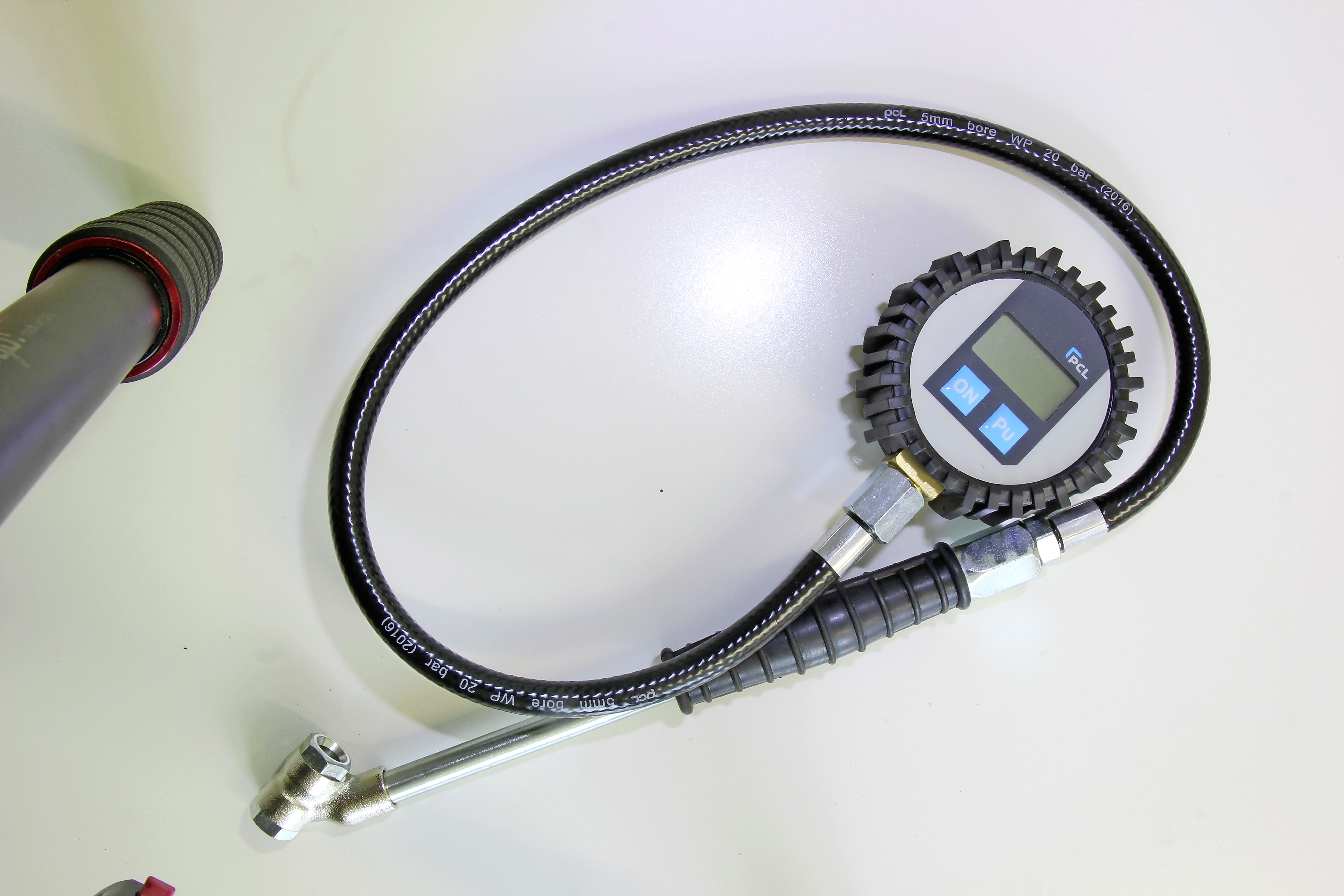
PCL DTPG8
Score: 7/10
Measurements: Psi, Bar, Kg/cm2
Decimal places: 1-2
Accuracy: +2.7%
Batteries: AAA x 2
Backlight: Yes
Torch: No
Price: £71.50. Buy now.
Of all the gauges we tested, this one was the most reliable for providing a readout across a range of wheels and damaged tire valves. It’s easy to see why when you look at the attachment that fits onto the valve. It’s the type found in workshops and at service stations, so it’s built to withstand abuse. And it’s a double attachment, so it should cater for the most awkward angles. This is reflected in the price. The manufacturing cost of the aforementioned attachment is probably more than the selling price of many of the other gauges! What you pay in price, you get back in quality.
This gauge feels sturdy and all of the hose components can be replaced. Just like the other gauges with hose attachments, the readout resets to zero once the end of the hose has been released from the tire valve. But unlike the similar gauges from Sealey and Laser, PCL’s has no bleed valve. It’s a no-nonsense digital tire pressure gauge, but it does have a backlight, and is the only one on test powered by two AAA batteries. This is accessed via a back panel and a single crosshead screw.
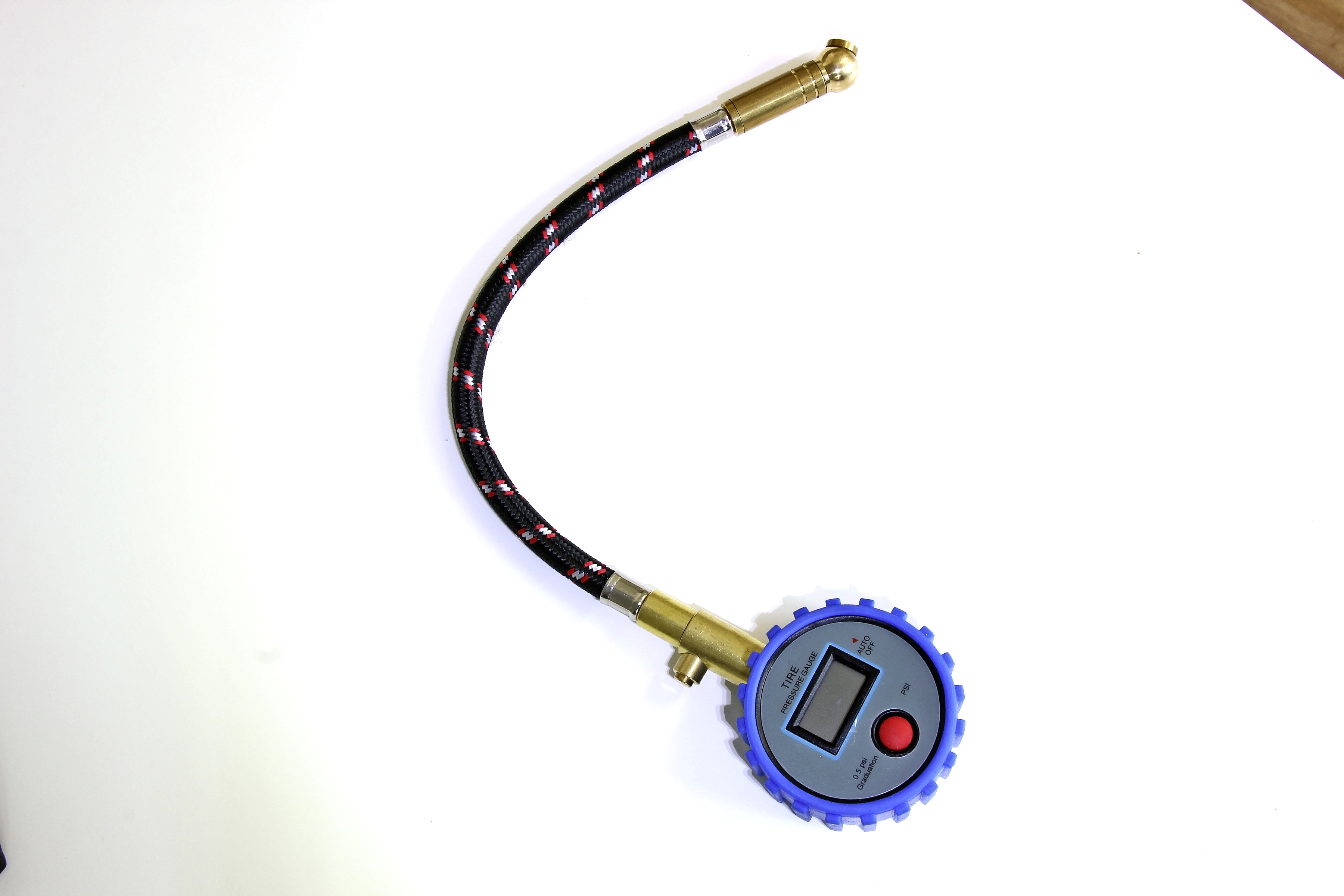
Sealey TST/ PG981
Score: 6/10
Measurements: Psi, Bar, kPa, Kg/cm2
Decimal places: 1-2
Accuracy: +3%
Battery: CR2032
Backlight: No
Torch: No
Price: £30.95. Buy now.
With the exception of a red ‘ON’ button, Sealey’s gauge with hose attachment is exactly the same as the Laser 2961. Even when we opened up the back to access the CR2032 battery, the components inside and the method of renewing the battery were identical.
There are no instructions, but we figured out how to switch between different units of measurement by holding down the red button. When the readout started to flash, we could then repeatedly press the button to change the unit. Attaching the end of the hose onto a tire valve is straightforward. However, we sometimes struggled to get an accurate fit and avoid air loss. It’s useful to be able to press the bleed valve on the other end of the hose (next to the gauge) to allow air pressure to be released from an over inflated tire, while checking the readout.
This type of digital tire pressure gauge resets their readout when the end of the hose is released from the tire valve.
We check 1,000s of prices on 1,000s of retailers to get you the lowest new price we can find. Fastcar may get a commission from these offers. Read more here.
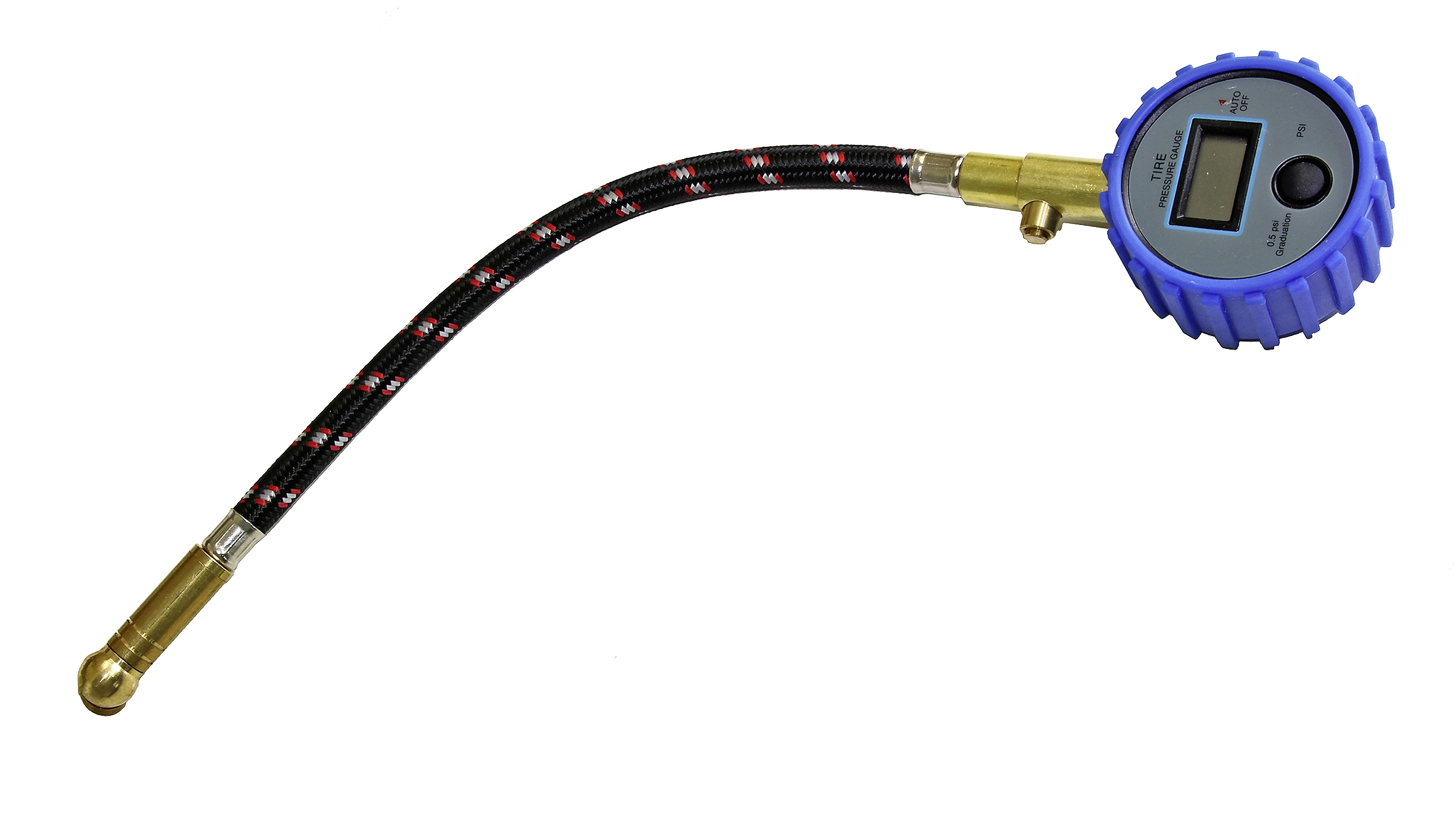
Laser 2961 Digital Tire Pressure Gauge
Score: 6/10
Measurements: Psi, Bar, kPa, Kg/cm2
Decimal places: 1-2
Accuracy: +3.1%
Battery: CR2032
Backlight: No
Torch: No
Price: £37.99. Buy now.
Virtually identical to the Sealey TST/PG981 gauge and with all the same functions. Even the instructions on the back of the packaging are similar. So, if your choice is narrowed down to these two models, shop around for the best price.
Laser’s gauge has a black button that operates all the functions. There are no instructions to show you how to switch between different units of measurement. Although, we discovered this by accident by holding down the button for a few seconds. Once the readout started to flash, we could repeatedly press the button to switch between the different scales. The hose and metal attachment are straightforward to use and fit onto a tire valve, but you have to accurately locate them to avoid air escaping.
The reading on the gauge resets itself once the end of the hose is removed. There’s a useful bleed valve, which enables it to remain attached to the tire valve and release air pressure if the tire is over-inflated.
There’s no backlight and no means of switching it off (it switches off automatically after 90 seconds), despite the instructions recommending holding down the ‘ON’ button.
It’s powered by a single CR2032 battery, accessed by undoing two crosshead screws on the back. Changing the battery is fiddly, requiring a small screwdriver.
We check 1,000s of prices on 1,000s of retailers to get you the lowest new price we can find. Fastcar may get a commission from these offers. Read more here.
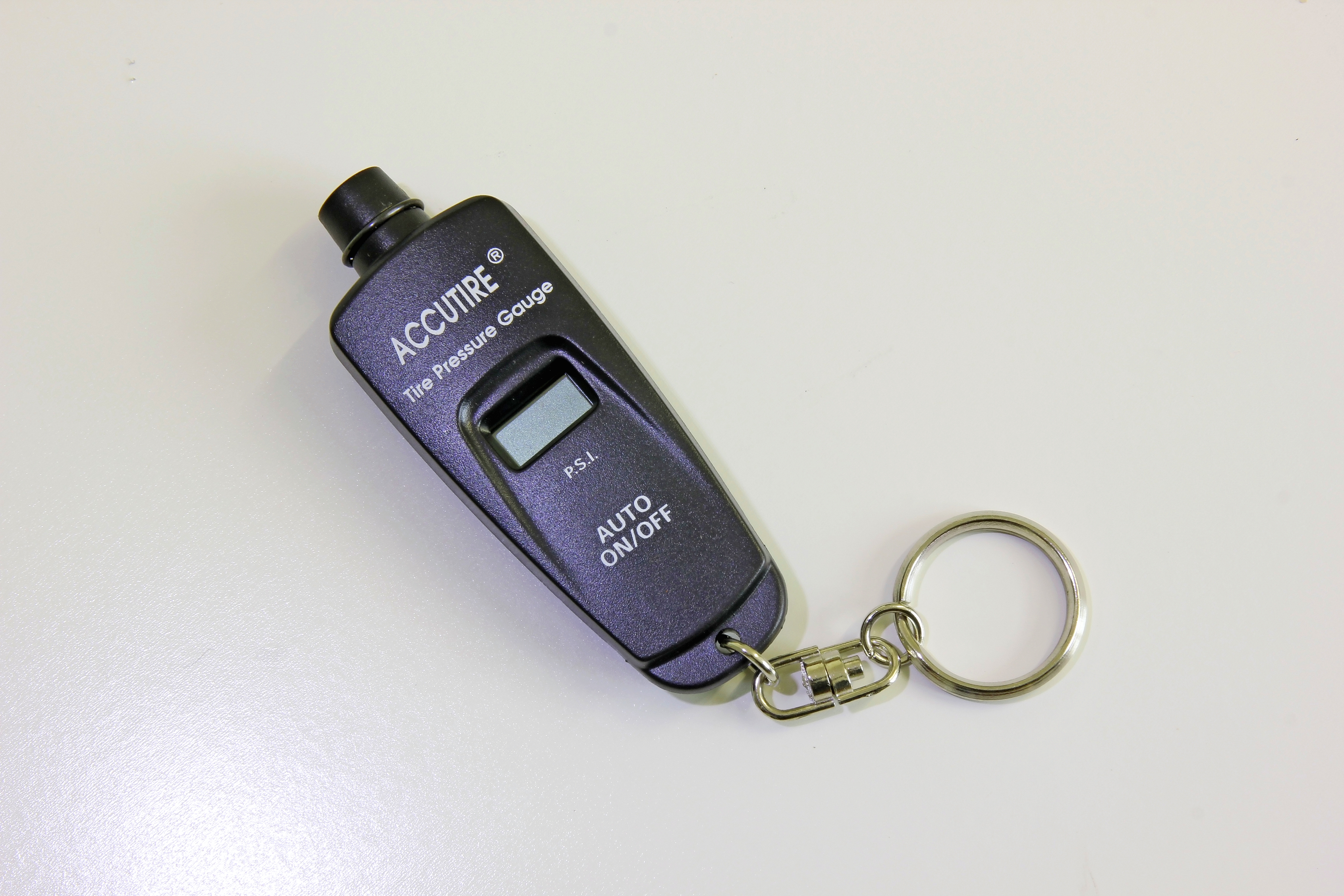
Accutire Keyring Digital Tire Pressure Gauge
Score: 5/10
Measurements: Psi
Decimal places: 0
Batteries: Not replaceable
Backlight: No
Torch: No
Price: £8.56. Buy now.
If all you need is a Psi reading for tire pressures, this Accutire gauge from Demon Tweeks may be the answer. With no backlight or torch, and no means of renewing the batteries, it’s almost twice the price of the no-frills gauge from Rally Design, but the RD gauge offers the full range of pressure readings. At times, it proved awkward to locate onto some of the tire valves we tested it on, resulting in either no reading or air leaking out and still no reading being displayed. It is, however, the smallest gauge we tested, being the size of a typical car key-fob. On the plus side, it comes with a handy keyring.
How we tested each digital tire pressure gauge
There are many aspects of digital tire pressure gauges that we wanted to assess. Top of the list was accuracy. As a result, we considered a suitable test procedure and looked into making a manometer. This consists of a large, waterfilled, U-shaped tube that’s sealed at one end with a Schrader valve. We could have used this to calculate the air pressure at one end and see whether the digital tire pressure gauges were accurate in their measurements.
However, the size of the manometer to cater for the range of pressure we wanted to test made it unfeasible. Plus, we had no way of knowing whether it would be accurate. So, we consulted one of the manufacturers of our digital tire pressure gauges – PCL of Sheffield – to see if they had a digital manometer. They agreed to lend it to us to use for testing, but were not involved in the test themselves.
We conducted three tests per gauge at 30-40Psi. We found all of the gauges were between 2.6-3% accurate, and all of them over-read (see the accuracy rating for each gauge). However, our findings were based on the assumption that the digital manometer was accurate.
So, we broadened our testing to look at how easy each gauge was to use, what additional features they offered (eg, a light), their price and whether the batteries could be replaced. We also tested the gauges on a variety of wheels to see whether particular tire valves were more awkward than others to access.
How to buy the best digital tire pressure gauge
Accuracy is key here. All of the above products tested within 3% of accuracy, with the best being 2.6% out. You want a pressure gauge that displays correct information, and therefore opting for a product that is greater than 3% out can result in under or over-inflated tires, both of which could be dangerous.
Other key factors in a digital tire pressure gauge are whether batteries can be replaced, or charged. Those without replaceable batteries mean that at some point, you’ll need to replace the whole item. This tends to be only a factor with the cheapest products that are less than $/£10.
Other, advantageous factors include a built in light. Although this isn’t necessary, it could be a useful tool in the winter to ensure your tires are at an optimum pressure for adverse weather conditions.
Relevant content:

